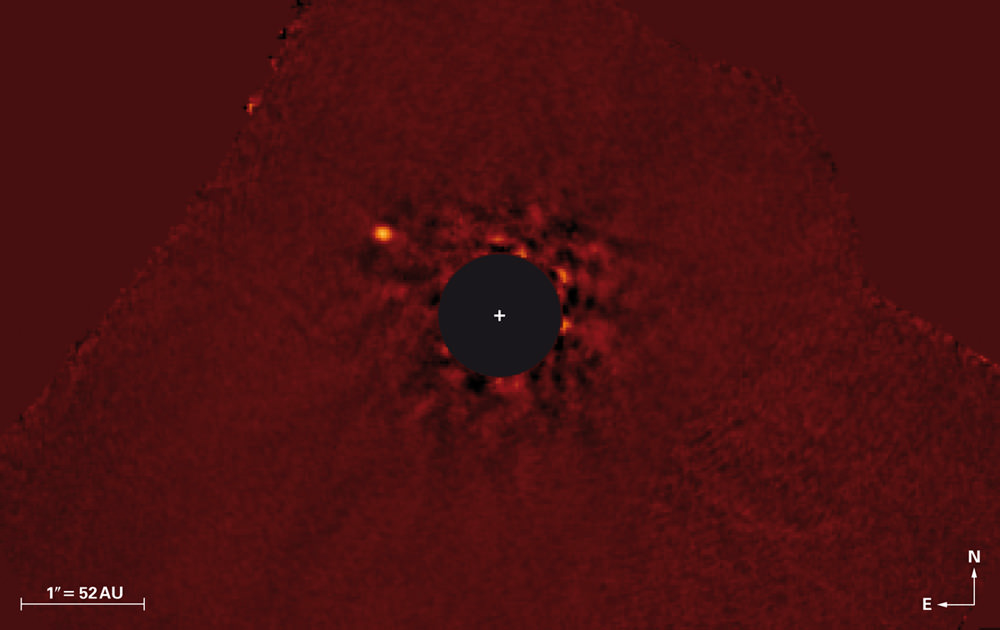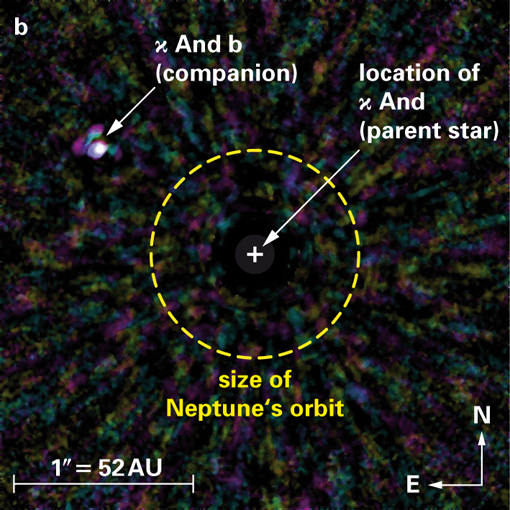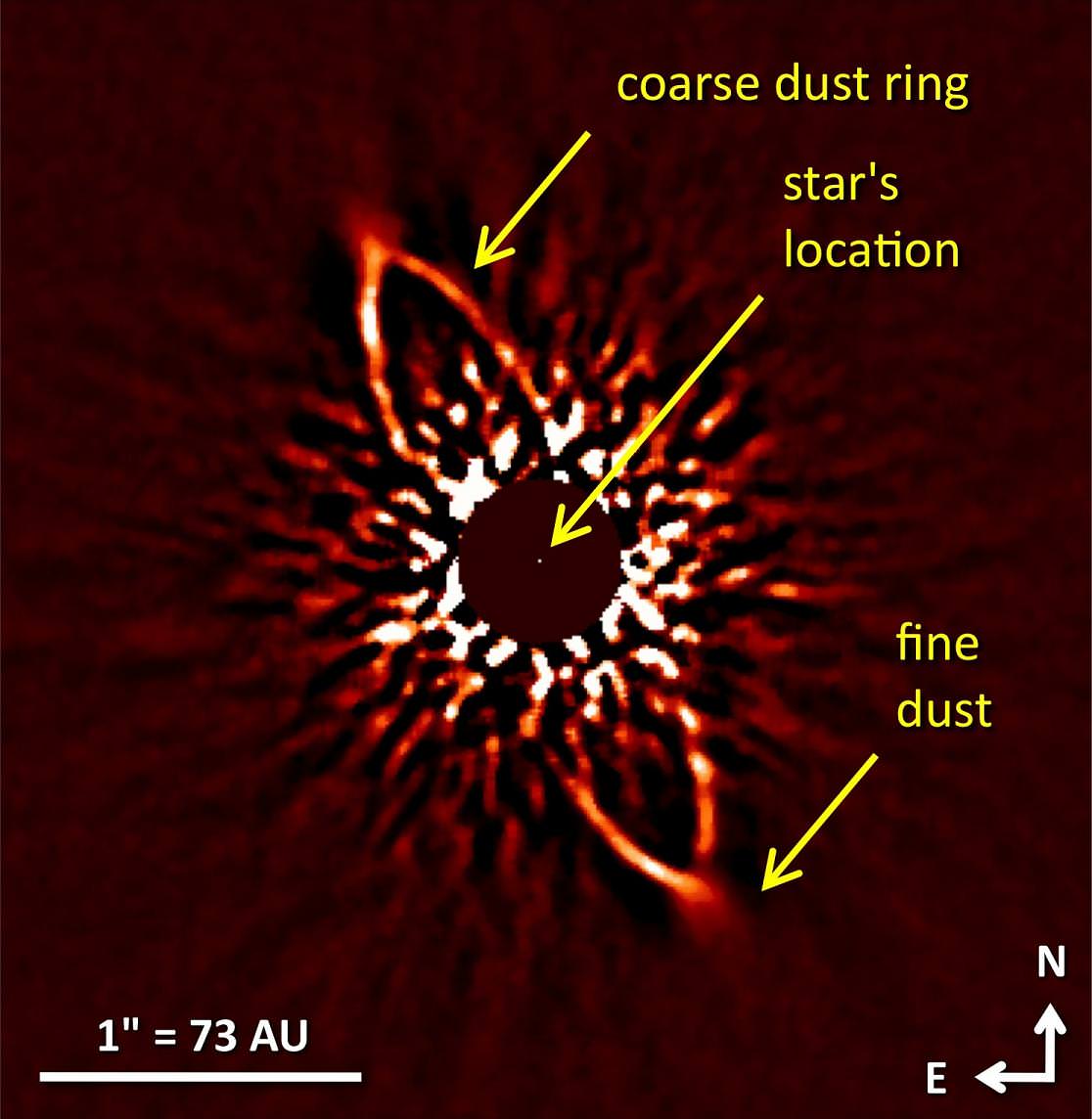False color, near infrared image of the Kappa Andromedae system, by the Subaru Telescope. Almost all of the light of the host star has been removed by the dark, software-generated disk in the center. Credit: NAOJ/Subaru/J. Carson (College of Charleston)/T. Currie (University Toronto)
Astronomers using the Subaru Telescope in Hawaii have found a super-Jupiter-sized exoplanet orbiting a massive star about 170 light years away from Earth. Not only have they detected the planet, but they’ve also taken a direct image of it. This is exciting because only a handful of exo-planets have been imaged directly. But the other interesting aspect of this newly-found planet is that it orbits its star at a distance comparable to Neptune in our own solar system. Astronomers say this is a strong indication that the planet formed in a manner similar to how it is believed smaller, rocky planets form: from a protoplanetary disk of gas and dust which surrounded the star during its earliest stages.
The star, Kappa Andromedae, is a naked-eye object that can be seen in the constellation Andromeda, and it has a mass 2.5 times that of the Sun, making it the highest mass star to ever host a directly observed planet. The observations were made by a team of astronomers from the Max Planck Institute for Astronomy and the University of Toronto and the College of Charleston, part of the SEEDS project (Strategic Explorations of Exoplanets and Disks with Subaru.)
“Our team identified a faint object located very close to Kappa Andromedae in January that looks much like other young, massive directly imaged planets but does not look like a star,” said Thayne Currie. co-author of the paper from the University of Toronto. “It’s likely a directly imaged planet.”
A “signal-to-noise ratio map” generated from the left image. The whiteness of each speckle indicates the probability that we are dealing not with an artefact (“noise”), but with the trace of a real object (“signal”). The white feature toward the upper left, representing a high signal-to-noise value, indicates the high-confidence, super-Jupiter detection. Credit: NAOJ/Subaru/J. Carson (College of Charleston)/T. Currie (University Toronto)
Kappa Andromedae (k And) is a very young star, with an estimated age of 30 million years (in comparison our Sun is around 5 billion years old). The planet, called k And b (“Kappa Andromedae b), is about 10% larger than Jupiter, but it is a heavy world — it has a mass of about 13 times that of Jupiter.
This means that it could very well be either a planet or a very lightweight brown dwarf, an object that is intermediate between planets and stars. However, the astronomers are leaning towards the circumstantial evidence which indicates that it is likely to be a planet.
Since stars are much brighter than their planets –typically by a factor of a billion or more – exoplanets are usually lost in the star’s glare when using traditional observational techniques. The Subaru team used a different technique called angular differential imaging, which combines a time-series of individual images in a manner that allows for the otherwise overwhelming glare of the host star to be removed.
In the infrared image, above, the tiny point of light that is the planet Kappa And b. Since the planet orbits the star at some distance, the SEEDS observing team was able to distinguish the object’s faint light by effectively covering up the light of the star.
The large mass of both the host star and gas giant provide a sharp contrast with our own solar system. Observers and theorists have argued recently that large stars like Kappa Andromedae are likely to have large planets, perhaps following a simple scaled-up model of our own solar system. But experts predict that there is a limit to such extrapolations; if a star is too massive, its powerful radiation may disrupt the normal planet formation process that would otherwise occur. The discovery of the super-Jupiter around Kappa Andromedae demonstrates that stars as large as 2.5 solar masses are still fully capable of producing planets within their primordial circumstellar disks. This is key information for researchers working on models of planet formation.
The astronomers will continue observations of the light emitted by k And b across a broad range of wavelengths in hopes of gaining a better understanding the planet’s atmospheric chemistry, as well as determining if other planets are in this system.
Read the team’s paper: Direct imaging of a `super-Jupiter’ around a massive star



